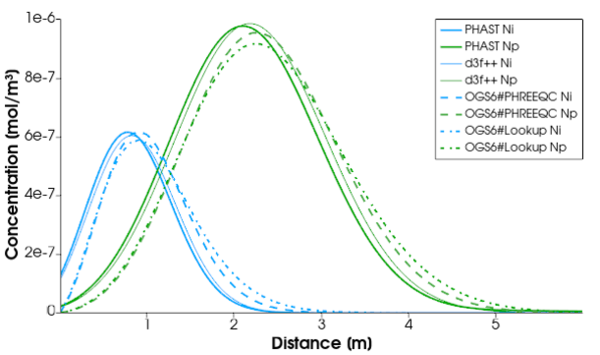Smart Kd-concept as efficient approach to improve geochemistry in reactive transport modelling
2 UFZ Leipzig
3 GRS Braunschweig
P 14.4 in Hydrogeologie und Standortauswahl für ein tiefengeologisches Endlager (in Zusammenarbeit mit DGGV)
A key component of risk assessment for radioactive waste repositories in deep geological formations is the prediction of radionuclide (RN) transport through the geosphere. One big challenge for such large-scale heterogeneous transport simulations is the integration of realistic geochemical models and their parameters at affordable computational costs. Sorption on minerals is an important retardation process and typically applying constant distribution coefficients (Kd) that can be easily included in reactive transport codes. One of the advantage of this approach is the computational efficiency, but it cannot reflect changes in geochemical conditions. On the other hand, mechanistic surface complexation models used for process understanding can be directly coupled to transport codes with geochemical solvers, but usually only at high computational costs. An alternative is provided by the smart Kd‑concept (www.smartkd-concept.de) [1], specifically developed to describe variable RN sorption in transport models as consequence of changing geochemical conditions over space and time. The philosophy behind this concept is to compute multidimensional look-up tables storing distribution coefficients - but here referred to as smart Kd as they are based on mechanistic sorption models. These tables can cover wide ranges of important geochemical parameters, e.g. pH, ionic strength, and concentrations of dissolved ions. The information stored in such a look-up table can be accessed by reactive transport codes at each simulation step. This approach is implemented in the code d3f++ [2] and OpenGeoSys OGS6 [3, 4] and validation results are presented here. The application case selected is sorption of repository-relevant RNs and possible migration scenarios through a typical sedimentary rock system covering potential host rock formations in Northern Germany. This serves as a comprehensive proof-of-concept and demonstrates the capability to describe the sorption behaviour in dependence of changing geochemical conditions quite well. As a side-effect, the large Kd-matrices that were computed can be further analysed by sensitivity and uncertainty analysis (SA/UA). Results of this case study showed that the smart Kd-approach goes considerably beyond the conventional concepts. We can illustrate that constant Kd‑values previously used in transport simulations are rough approximations (and not necessarily conservative ones), as in reality, they rather range over several orders of magnitude. Moreover, with the results from the SA, those input parameters influencing strongest the radionuclide retardation can be identified. The results of the transport simulations with the newly implemented smart Kd-approach showed a good agreement to full reactive transport simulations using PHAST [5] or a direct coupling OGS6#PhreeqC (Fig.1) and reflect the radionuclide-specific retardation effect. This real application case serves as a benchmark for field-scale transport simulations.

[1] Stockmann et al., Chemosphere, 187, 277-285 (2017).
[2] Schneider et al., Report GRS-392 (2016).
[3] Jang et al., OpenGeoSys Tutorial III, 103 (2018).
[4] Kolditz et al., Environ. Earth Sci., 67, 589-599 (2012).
[5] Parkhurst et al., U.S.G.S. Report 6-A35 (2010).

